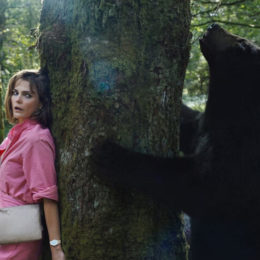BLOOD & GOLD. Tarantino-like [Review]

Quentin Tarantino’s style can be inspired by, but it’s hard to copy, although it’s not impossible. Fortunately, the creators of Blood and Gold did not make this mistake and followed their own path, a bit Tarantino, yes, but much more marked by the reflection of a nation that became a carrier of ideology and war, bringing precisely designed death. Who like who, but the Germans have experience in telling stories about the war and they used it well. Blood & Gold is a brave film, not devoid of plot weaknesses, but it makes up for it with aesthetics, atmosphere and a few scenes, but which ones. It’s a western, war movie, comedy and drama rolled into one. It can be successfully included in the classics of German, contemporary cinema reflecting on Nazism and German society in the 20th century, next to All Quiet on the Western Front and Generation War.
I’ll start with a little spoiler. Reviews don’t always have to be a dry listing of the pros and cons of a movie with a summary at the end. Such scenes in the cinema are rare – so scary and symbolic at the same time, which is why fans of Quentin Tarantino’s style will certainly be encouraged by its description, and it will be an excellent core of a critical text about the film. So let’s imagine the character of the antagonist who dominates the plot in the movie. He is a bit of a stray dog in the SS, an officer, an Obersturmbannführer in the paramilitary classification of Schutzstaffel ranks. His name is Von Starnfeld (Alexander Scheer). He wears a mask that hides terrible scars and does not take it off throughout the film, until that one, only moment when he lets us viewers know him fully. The war is about to end. Residents of smaller towns know perfectly well that the Third Reich has lost and the Allies are on the brink, so they try to survive, adapt, just like after 1934, when Nazism flooded Germany. So they carefully hide all the memorabilia of Hitler and the ideology of the great pan-Germanic Aryan race. Von Starnfeld, however, is different. He refuses to believe that the Nazis have already lost, even when he hears American guns in the distance and sees American planes in the sky. Von Starnfeld leads a group of outcasts from the SS. Some deserters, some ideological scams who are looking for Jewish gold together. So there is some rationality in this madness, although the search for this treasure takes place in a psychologically twisted atmosphere similar to Von Starnefld’s tirades in praise of Nazism.

By a strange coincidence, our antagonist finds a girl who reminds him of his former love in the town he is searching. The scene I have in mind starts right when Von Starnfeld walks up to the door and turns the key in it. Elsa, imprisoned by him, is forced to listen to his most personal story, which is a reflection of the moral and emotional disruption that German society experienced under the influence of Nazi ideology. Von Starnfeld recalls his former girlfriend, whom he loved very much, but could not be with her. He was not allowed to marry her. And the reason was quite prosaic in those bad times. Rebecca was Jewish. The lieutenant colonel knew perfectly well that he would end up in a camp, and because he loved her very much, he decided to kill her. He did. Standing in front of the terrified Elsa in that room and weaving this romantic-dramatic story of a love-mad killer, he finally headed towards the mirror. Staring at his deformed face, slowly taking off his glasses and mask, he surmised that he had shot Rebekah. The camera deftly refocused as a maskless face appeared in the foreground in the mirror. This sparing of the viewer, however, did not last long. Von Starnfeld began to dig something out of his eye socket in the close-up, this time in full focus. It turned out to be a ring. What a loving keepsake of a shot loved one. However, he found a new one and wanted to give her what he considered the most valuable, kept inside his body, in this other part, marked by decay.
Related:
Kneeling before Elsa and placing a previously wiped ring on her finger, Von Starnfeld wanted to atone for Rebecca’s murder in a peculiar way, a death caused for ideological reasons, but paradoxically also humanitarian ones, however it sounds. In the mind of the lieutenant colonel, the fate of the Jew functioned as sealed. A Jew was not human, nor was a homosexual or mentally ill or mentally retarded. Operating in such a narrow moral perspective, Von Starnfeld found himself in a dead end situation. He hit the rational judgment of reality finally when he slipped Elsa a ring and said he would never leave her. That he would always protect her, but as Rebecca, not Elsa.

The scene I am describing here is neither flashy nor overly pathetic. It is almost an intimate theater, showing relationships and motivation, and the climax is like Tarantino’s full of unusually designed violence. That’s the whole film, with almost western music, church carnage, evocative cinematography and inventive fight choreography. There are many genres to be found in Blood & Gold, and the ending will certainly surprise many viewers. Maybe in fact, if people see gold, they become the same, whether they live in the Third Reich or in the democratic United States? One more thing is important in the reception of this film. The German community is still torn apart, in a sense contaminated. At all costs, the creators want to make these scars anew, so that they drag, hurt as little as possible, and stand out from the rest of the social body. It’s still too early for this to be successful.





